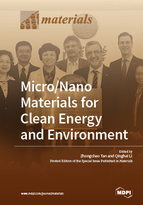Micro/Nano Materials for Clean Energy and Environment
A special issue of Materials (ISSN 1996-1944).
Deadline for manuscript submissions: closed (31 March 2019) | Viewed by 46816
Special Issue Editors
2. Executive Director, Tsinghua University–University of Waterloo Joint Research Center for Micro/Nano Energy and Environment Technology, Beijing, China
Interests: green energy; air emission control; indoor air quality; aerosol; nanotechnology
Special Issues, Collections and Topics in MDPI journals
2. Department of Energy and Power Engineering, Tsinghua University, Beijing, China
Interests: solar energy utilization; biomass and waste combustion; industrial boiler development
Special Issue Information
Dear Colleagues,
Energy and environment are two interrelated global challenges. Energy resources are depleting while air pollution and greenhouse emissions are deteriorating our only habitat, the planet Earth. New materials are critical to winning the final battle for sustainable living environments and against climate change. Thanks to countless renowned researchers and engineers all over the world, like you, technologies advance every day. New knowledge has to be synthesized and shared with the international community in a timely and regular way. Therefore, through this Special Issue, I am seeking your original, unpublished works that describe recent advances in micro/nano materials in relation to clean energy and the environment. I extend my warm invitation for research papers from a broad range of topics related to micro/nanostructured materials aiming at future energy resources, low emission energy conversion, energy storage, energy efficiency, air emission control, air monitoring, air cleaning, and many other related applications. High quality manuscripts will be published in the Special Issue after rigorous peer-review. Our team will work hard towards the rapid and wide dissemination of your valuable research results, recent developments, and novel applications in the area of the materials, energy and environment.
This Special Issue is dedicated to the first anniversary of the Tsinghua University–University of Waterloo Joint Research Center for Micro/Nano Energy and Environment Technology. (https://uwaterloo.ca/jcmeet). Full papers, communications, and reviews are all welcome. I look forward to receiving your work.
Prof. Dr. Zhongchao Tan
Assoc. Prof. Dr. Qinghai Li
Guest Editor
Manuscript Submission Information
Manuscripts should be submitted online at www.mdpi.com by registering and logging in to this website. Once you are registered, click here to go to the submission form. Manuscripts can be submitted until the deadline. All submissions that pass pre-check are peer-reviewed. Accepted papers will be published continuously in the journal (as soon as accepted) and will be listed together on the special issue website. Research articles, review articles as well as short communications are invited. For planned papers, a title and short abstract (about 100 words) can be sent to the Editorial Office for announcement on this website.
Submitted manuscripts should not have been published previously, nor be under consideration for publication elsewhere (except conference proceedings papers). All manuscripts are thoroughly refereed through a single-blind peer-review process. A guide for authors and other relevant information for submission of manuscripts is available on the Instructions for Authors page. Materials is an international peer-reviewed open access semimonthly journal published by MDPI.
Please visit the Instructions for Authors page before submitting a manuscript. The Article Processing Charge (APC) for publication in this open access journal is 2600 CHF (Swiss Francs). Submitted papers should be well formatted and use good English. Authors may use MDPI's English editing service prior to publication or during author revisions.
Keywords
- micro/nanomaterials
- energy
- environment








